How the British divide & rule DIVIDED Sinhalese & Tamils
Posted on December 26th, 2018
There is a reason why history is important. Everything has a history. Unless people know the true background not only is the solution impossible, but too often the solution may aggravate the problem. Our island was never invaded but ceded to foreign invader rule from 1505 to 1972 when the island’s sovereignty and governance fell into local hands. This part of history everyone should know by now. The Kandyan Convention ceded the island to British in 1815. The divisive politics by the British together with that of the Portuguese & Dutch hold the roots to the legacy of ills that we today face.
British divide & rule – political & racist policies
1833 saw 1st Constitutional reforms came via Colebrooke Commission recommending a 18 member Legislative Council & an Executive Council.
The 3 Sri Lankan non-official members were to be nominated by Governor based on RACE (1 low country Sinhalese / 1 Tamil / 1 Burgher)
So who was discriminating people by race? The British! This was how the British planted the seed of communalism into politics.
In 1889 creating further divisions in the community the British nominated a Kandyan and Moor as non-official members.
1919 Crew-McCallum reforms should be forever remembered for REFUSAL by British to ABOLISH Communal Representation.
Legislative Council was increased from 11 to 21 & the 6 non-official SL members nominated by Governor was again by race – 2 low country Sinhalese, 2 Tamils, 1 Kandyan & 1 Muslim.
By enforcing communal representation as a policy the British succeeded in nurturing the communities to beat the communal drums & they encouraged the minorities to beat it more & this soon led to Tamils demanding additional seats claiming that to be the leverage to balance the numerical representation Sinhalese majority had by population. Thus, Tamils secured additional seats politically though these Tamils never represented or desired to represent the interests of their people, a scenario that has not changed much even in 21st century.
A striking example that communal politics was prevalent among Tamils more than Sinhalese can be given in the manner Sinhalese voted for Ponnambalam Ramanthan in 1917. The election brought Sinhalese on par with Tamils in terms of representatives in the Legislative Council though at this time even Indian Tamils out-numbered the Ceylon Tamils numerically.
1920/1923 Legislative Council continued communal representation but included territorial representation too.
1924 Registered voters were 204,997 – just 4% of a total population of 5m
1921/1924 Elections saw British flogging both communal & caste cards.
Ceylonese voter = born in Ceylon, graduate, barrister, advocate, proctor, authorized notary, registered medical practitioner, licensed surveyor, engineer
Ceylonese candidate = 25 years & above, not be bankrupt, no criminal case or debarred from practice.
The British had penetrated into society so much that even CNC had to plead with contestants not to campaign on caste lines.
Under Governor Hugh Clifford (1925-27) came the Donoughmore Commission & a new constitution in 1931 and Sri Lanka becoming first Asian colony to get universal franchise. Communal politics was such that the Sri Lankan Tamils opposed universal franchise as it meant the power of the Sinhala majority would surface. 1931 constitution replaced communal representation with territorial representation and British now shifted gears & pretended to side with the majority thus further aggravating communal hate. The British shifted back to favoring Tamils & encouraged G G Ponnambalam’s 50-50 representation which the Soulbury Commission rejected as a mockery of democracy.
1930 delimitation commission marked 1 seat per 100,000 persons.
1931 / 1936 General Elections with colour being used instead of symbols even on ballot boxes. Campaigning ended up on caste/religious lines & same party individuals contesting each other.
1946 Soulbury Commission introducing parliamentary system with House of Representatives & a Senate.
The British experiments on our people using communal divisions was succeeding. By infesting the psyche with communalism the British succeeded in engraving communal thoughts into the polity & though in later years they pretended to champion against it, in reality they were jubilant that their experiment was & would continue to succeed. Communalism & politics was now synonymous.
British & Caste system
British were quick to flog the caste differences to. Though caste played no role in political life or administration pre-colonial rule, post-colonial it became the perfect tool to divide people.
Till 1920, the Karawas were dominant in legislative council & then Govigama took over. Then British enabled Sinhalese Christians to dominate the legislature to upset the majority Buddhists. The British also succeeded in creating animosity between the Kandyans and the low country Sinhalese.
British divide & rule – education & employment policies
The British used education as a means of not only converting Buddhists/Hindus but to create a new group of elite first class society that would think like the British & act in future in the interests of the West (such people are infamously known as brown sahibs, sepoys, lascoreens) These individuals were taught to think only of themselves & their perks & not make demands on behalf of their own. Division between Sinhalese/Tamils were created by showering more privileges upon Tamils who became more educated than the Sinhalese & these elite class/caste were mentally brainwashed to think themselves more superior & deserved more entitlements than the Sinhalese. The ramifications of such brainwashing came out through the excessive demands made politically.
The reality was that it was ELITIST that were nurtured to rule along communal lines and 96% became non-voters. These ELITE actually opposed giving universal franchise to the 96%. They even opposed territorial representation.
The British had sown the seeds of communal disharmony into the political system by encouraging politicians to think communally, demand communally & act communally. It would filter with time to the rest of the populace & would be seen in voting trends & election campaigning & delimitation representations.
British divide & rule – Disunity sacrificing Unity
Sri Lanka did not offer as much resistance to British rule unlike in India. There was no nationalist organization like India’s Indian National Congress. The ‘educated’ Sri Lankans of all communities were those that shared commonalities amongst themselves & were neither representative or interested to speak on behalf of or fight for those suffering at grassroot levels though their political rhetoric displayed otherwise.
However, in 1919 the Ceylon National Congress was formed & it worried Governor Manning. The British did not wish for the communities to unite. When the CNC demanded territorial representation the British encouraged the Kandyan Sinhalese to demand a communal electorate & thus the British was able to divide the Sinhalese South/Kandyans. The British also upset the CNC by creating a rift within by favoring the Tamils which led to CNC split & Tamils living CNC to form Tamil Mahajana Sabha in 1921.
British nurtured Communal-Political system
1931 delimitation commission defined an electoral district as consisting of a population of 70,000 to 90,000 (50 electoral districts depending on population size)
Indians brought from Tamil Nadu by colonial British had also increased. by 1939 there were 235,000 Indians registered as voters.
First-past-the-post system (single member constituency) plus area weightage gave Tamils & Muslims in thinly populated North East additional representation where there was little or no Sinhala representation.
Multi-member electoral districts also enable minorities to secure representation in Sinhala dominated areas.
This system with time has caused much political imbalance and has become aggravated by territorial representation along communal lines. Politicians were taught to flag communal politics & voters were also drawn towards communal sentiments particularly in minorities.
Constituencies based on population
Western province making 5.65% of geographic area got 28% of seats
North Western province with 15.82% geographic area got only 2% of seats.
What is interesting is that even in 1947 … a year after UNP was formed, UNP functioned as a coalition combining the Ceylon National Congress, Sinhala Mahasabha, Ceylon Moor’s Association & the Ceylon Muslim League. This explains the natural affinity of Muslims towards the UNP. In just 5 years UNP faced its first challenge when SWRD Bandaranaike broke away to form the SLFP in 1951 and UNP leader D S Senanayake dies in an accident in 1952. Noteworthy too is the anti-Marxist/Communist line UNP adopted that aligned with the Western election propaganda. Dudley Senanayake (UNP) won the 1952 elections with the help of the Tamil Congress showcasing the post-independence UNP-minority alliance for electoral victory.
At every level since independence communal politics drained the country of properly policy-based leadership and the root of this malady is with the British. Confounding matters further in the 1965 elections the Roman Catholic church extended its support to the UNP & ITAK requested Tamils in Sinhala majority areas to vote for the UNP, a scenario that continues to this day.
What was also clear was that whenever the majority became disunited the minorities made bigger demands. ITAK’s 1965 demand to support UNP was on the condition that UNP would implement its demands – formation of district councils & making Tamil the language of administration in North & East.
As you can see by infusing the political system to think & act on communal lines the British not only drove this communal element into political parties but people also began thinking & voting on communal lines and with time & circumstances the rhetoric got worse.
If everyone knew their history they would be aware of how this division & communal rhetoric started as it was planted by the western colonial occupiers & institutionalized by the British.
Shenali Waduge
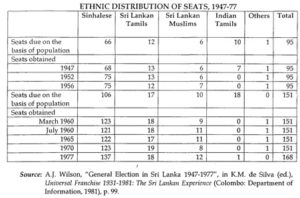
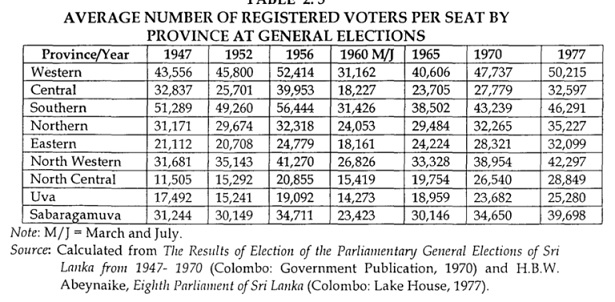
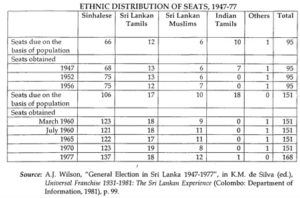
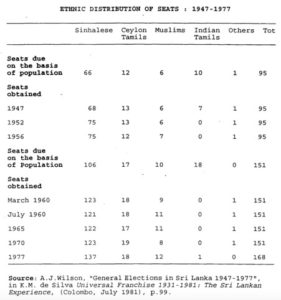
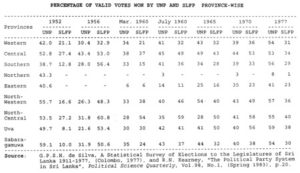
December 25th, 2018 at 8:55 pm
Hindus divide you form birth. Caste and no Caste. Then within Caste. 6000 years old,
British learned it from Hindus.
December 28th, 2018 at 2:51 pm
Thank you Shenali for highlighting all these atrocities by the British. After they left the well trained brown sahibs like Ranil and Chandrika have kept the tradition alive. Tamil leaders like Wigneswaran are the worst. People like Wigneswaran are very deceitful people. He got his two sons married to Sinhala women (Vasudeva’s daughters) who are now looking after him. Yet he told the Tamils not to marry Sinhalese. He got free education and a top position in the land as a Supreme court judge. He lived most of his life in Cinnamon gardens Colombo 7, yet he goes around saying the Tamils are discriminated against. He is same as Radhika Coomaraswamy who when she was in the UN was trying to get UN to send troops into Sri Lanka under the R2P. She failed to mention that her father Raju was sent as Ambassador of UN by JR. Her brother is now the Governor of the Central Bank. Our niwata Govt has given her Dehshamanya award. But not MR who saved our country. Such is the justice in this Kali Yuga.
Instead of one President, we could have a Governing body made up of at least 3-10 senior, educated, well known patriotic leaders, with experience and good character and ethics. We can have elections similar to the local government or the provincial elections and then choose a group of such 10 people who are mature, educated and with good character and morality and form a Council to govern the country along with a Cabinet of Ministers. The Governing Council formed by the UNP was a body with the most unsuitable people who have no loyalty to the country and have bad character. Unlike the current multi-party system where all the energy is wasted in hot air blasting each other in the Parliament, the group of 3-10 could work together to solve the problems of the country. We can see how fast China has come up while most of the Western democracies are floundering. India adopted the multi-party system and today they are also floundering. When the colonized countries freed them colonizers left behind a Trojan horse for each country to experiment which was the multi-party democratic system. You can see the net result. Even the Legal bodies appear to have the Western mindset and cannot think in the local context. Sri Lanka MUST try to work out a system of Government suited to our Culture and situation being surrounded by enemies from all sides. We have the enemies within like the TNA whose allegiance is to Tamil Nadu and the Muslims whose allegiance is to the Middle East and other Muslim countries. They only want to convert all the Kafirs to worship Allah and they will do it by any means. We also have the Christian groups who get funding from West to convert the Heathens. If the Sinhala Buddhists who are threatened try to protect themselves by asking for a rightful place for Buddhism then the West will brand us as not allowing Religious Freedom.
Ranil is an agent of the Multinational Corporations along with his guard dog Anura Kumara. Ranil’s policy is Neoliberalism which means to sell the whole country to Corporations who will then Glyphosate and rape the country to make a profit while our people starve as they did in India during the 1770s under the British.
December 28th, 2018 at 7:53 pm
Oh Sacred Cows of India and million gods!
It was a British-Indian Empire that we were under..
British are gone and Indian Colonial Parasites are left and they run our country and other Indian Colonies from Fiji to Guyana.
Open your senses and brain or search the internet.
See who came to install Sirisena as Commonwealth Election Monitor? Jagdeo an Indian Parasite from Guyana.
I is time for we Sinhalese to blame our own be it Ranil or Mahinda and see we are all victims of the Indian Empire and Indian Colonists.
The Tamils and other Indians are Indian who arrived here under the British Fire Power.
Britissh did not have to divide they were Indian Parasites and we were the Hosts.